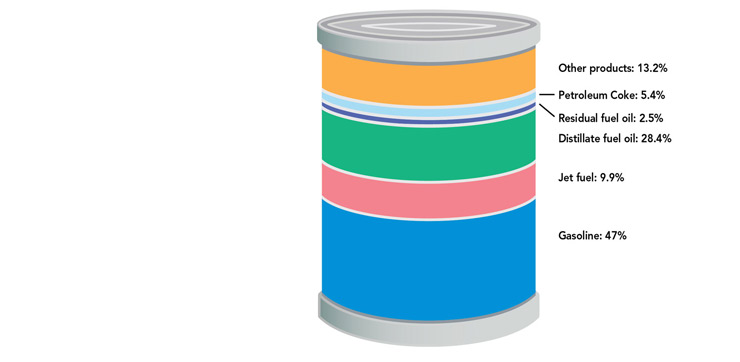ARCHIVED – Canadian Refinery Overview 2018 – Energy Market Assessment
This page has been archived on the Web
Information identified as archived is provided for reference, research or recordkeeping purposes. It is not subject to the Government of Canada Web Standards and has not been altered or updated since it was archived. Please contact us to request a format other than those available.
Refinery Profitability
Refineries maximize profit by maximizing yields of high value products like transportation fuels (gasoline and diesel) while minimizing shipping costs of their feedstock (crude oil) and products. Maximizing profitability is also a balancing act: a refinery can reduce the costs of its feedstock by refining heavy crude oil instead of light crude oil, because light crude oil is more expensive; however, heavy crude oil is more difficult and costly to refine, as it requires additional equipment like a coker.
Compared to light crude oil, refining heavy crude oil typically yields higher proportions of lower value products, all else being equal.
Figure 2: Petroleum Products Made From a Barrel of Crude Oil

Source: Energy Information Administration
Description:
The infographic representing a barrel of oil breaks down the various products that a typical refinery will yield from one barrel of oil. Gasoline makes up the largest portion with 47%. Next is Distillate fuel oil (diesel) at 28%. Jet fuel consists of 9.9%. Petroleum coke and residual fuel oil account for 5.4% and 2.5% respectively. Lastly other products make up 13.2 %.
A barrel of crude oil equals 42 U.S. gallonsFootnote 1 (159 litres) and produces approximately 170 litres of RPPs when refined. (Figure 2) The outputs from refining are greater than the inputs, because most of the products they make have a lower density than the crude oil they process. This increase in volume is called processing gain. Different refineries can also produce different yields because of the structure and composition of their processing units.
Demand for RPPs, particularly for gasoline, is somewhat seasonal. In the spring, refiners maximize production of gasoline to meet increased demand during the summer driving season. There is also more asphalt produced in the summer because of increased road construction. In the fall, production of light fuel or heating oil increases because of higher heating demand during winter.
What is Heavy Crude Oil? Generally, a crude oil that is very viscous and has a density greater than 900 kg/m3, or an API gravity below 25.
What is Light Crude Oil? Generally, crude oil with low viscosity which flows freely at room temperature. There are varying thresholds for the line between light and medium crude oils. Light crude oil is also a collective term used to refer to conventional light crude oil, upgraded heavy crude oil, and pentanes plus.
- Date modified:
